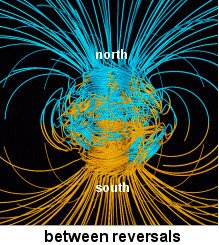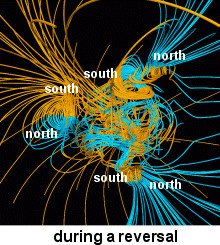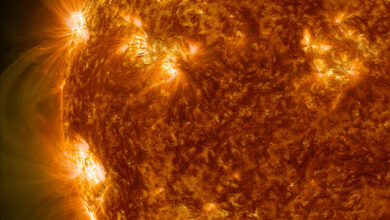
You may have noticed the deluge of articles recently claiming that a magnetic pole shift is imminent and we’re all about to get blasted back to the stone age. Are the reports true? Should you prepare for the worst, restock your canned peas?
Here’s what they claim will happen: During the shift, the magnetic field surrounding our planet will weaken, perhaps down to only one-tenth its current power. This will allow harmful solar and cosmic rays to ravage Earth, wreaking untold devastation around the world. Our satellites will fail, our electrical grids will collapse. We’re talking decades-long blackouts, scorched landscapes, and really bad sunburns.
The shift will be so cataclysmic that it will render parts of Earth downright uninhabitable. Species will go extinct. We are completely and utterly doomed. The only question that remains now is: when?
How true is any of this?
Well, the fun news is that a pole shift will eventually happen. In fact, NASA has provided these nifty images to illustrate just what a pole reversal looks like.
This is your Earth between pole shifts:

And this is your Earth during a pole shift:

Any Questions?
That looks pretty gnarly, no doubt. But how worried should we be?
The last pole shift happened about 780,000 years ago, with another almost happening 40,000 years ago. In fact, pole shifts have occurred regularly throughout the history of Earth, and take upwards of thousands of years to complete.
According to NASA, “reversals have happened at least hundreds of times over the past three billion years.” The problem seems to be how our modern technological civilization will cope with the next one.
Scientists estimate that pole shifts occur roughly every 200,000 to 300,000 years, so we actually are due for another. And there are, indeed, signs that one is near – a draining of molten iron and nickel from the Earth’s core, for example, according to Futurism.
We also have a few signs of a shift in progress. According to NASA, the North Pole is now moving northward at about 40 miles per year, which is faster than it had been moving last century. It’s also not uncommon for airports to update their runways to reflect magnetic field changes. Whether or not these slight shifts will soon turn into a full-blown reversal is unknown.
All of that said, is a pole shift actually dangerous?
Most of the current concerns arise from an article written by Alanna Mitchell in Undark Magazine, which outlines the possible damage that could be done to our satellites and electrical grids. This was then picked up by a nearly infinite number of online tabloids.
But any potential doomsday scenarios are not without their critics.
Happens All the Time
In the heat of the ill-fated 2012 Mayan apocalypse, for example, NASA posted a response to those worried about a destructive magnetic pole shift, titled “2012: Magnetic Pole Reversal Happens All the (Geologic) Time.”
In it, they explained the basics of pole reversals, as well as how today’s scientists understand the effects of past reversals:
“The Earth’s magnetic field determines the magnetization of lava as it is laid down on the ocean floor on either side of the Mid-Atlantic Rift where the North American and European continental plates are spreading apart. As the lava solidifies, it creates a record of the orientation of past magnetic fields much like a tape recorder records sound.”
Examining sediment cores deep in the ocean allows them to view those records, specifically the effects of the last reversal 780,000 years ago.
What they’ve found is that “the fossil record shows no drastic changes in plant or animal life” during that time. They’ve also found no evidence that the magnetic field has ever disappeared completely. Even then, in the event of a weakened field, Earth’s atmosphere continues to help shield the planet from harmful radiation.
NASA ended their 2012 rebuttal with a very straightforward statement: “There is nothing in the millions of years of geologic record to suggest that any of the 2012 doomsday scenarios connected to a pole reversal should be taken seriously.”
Are We Doomed?
Can the same be said for a 2018 pole reversal doomsday scenario? Probably. In response to that Undark article, Robert Walker over at Science 2.0 posted his own rebuttal, which seems to cover many of NASA’s points in greater detail. He calls it all “nonsense, utter codswallop.” It’s an interesting read.
While GPS would most certainly be affected, and we’d likely have some problems with electric grids, these are obstacles we could ultimately handle, he writes, in the same way we handle other natural disasters, like hurricanes.
As for claims that parts of Earth will be rendered uninhabitable, he’s not having any of that. At most, he says, you may “need to wear more sunblock cream on sunny days.” Some satellites would need to be “hardened,” and astronauts aboard space stations would require greater protection. Other than that, civilization as a whole would not experience an existential threat.
So, perhaps a magnetic pole shift is not quite the end of the world as we know it. On the other hand, things are much different now than they were 780,000 years ago. You never really know what’s going to happen until it happens. I guess some day we (or, more likely, our descendants) will find out.






